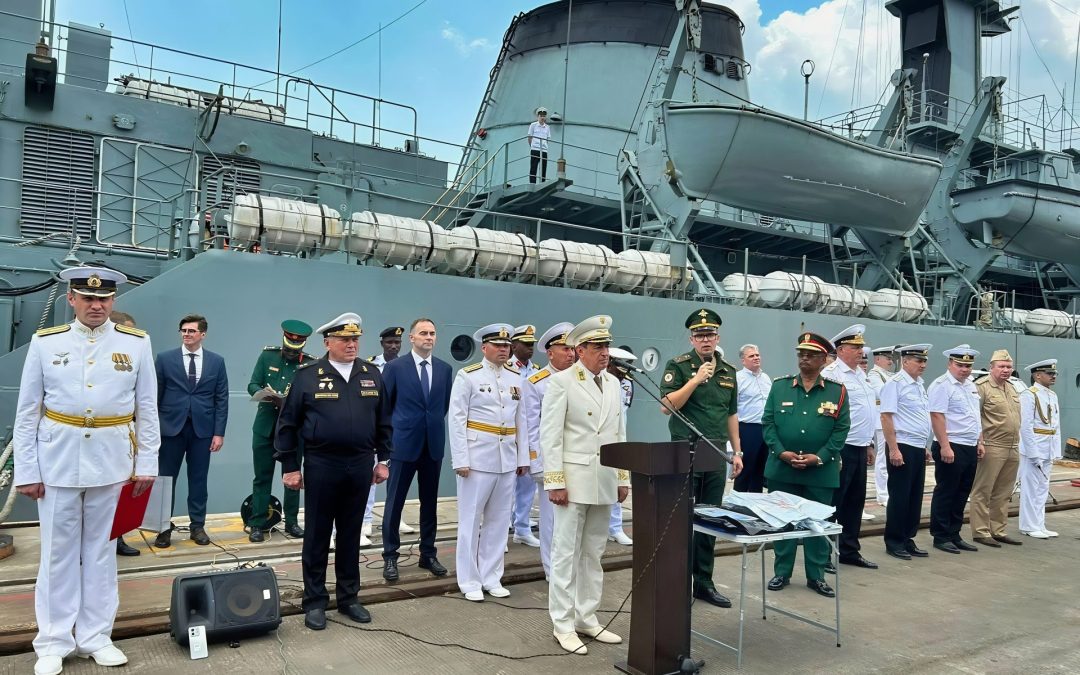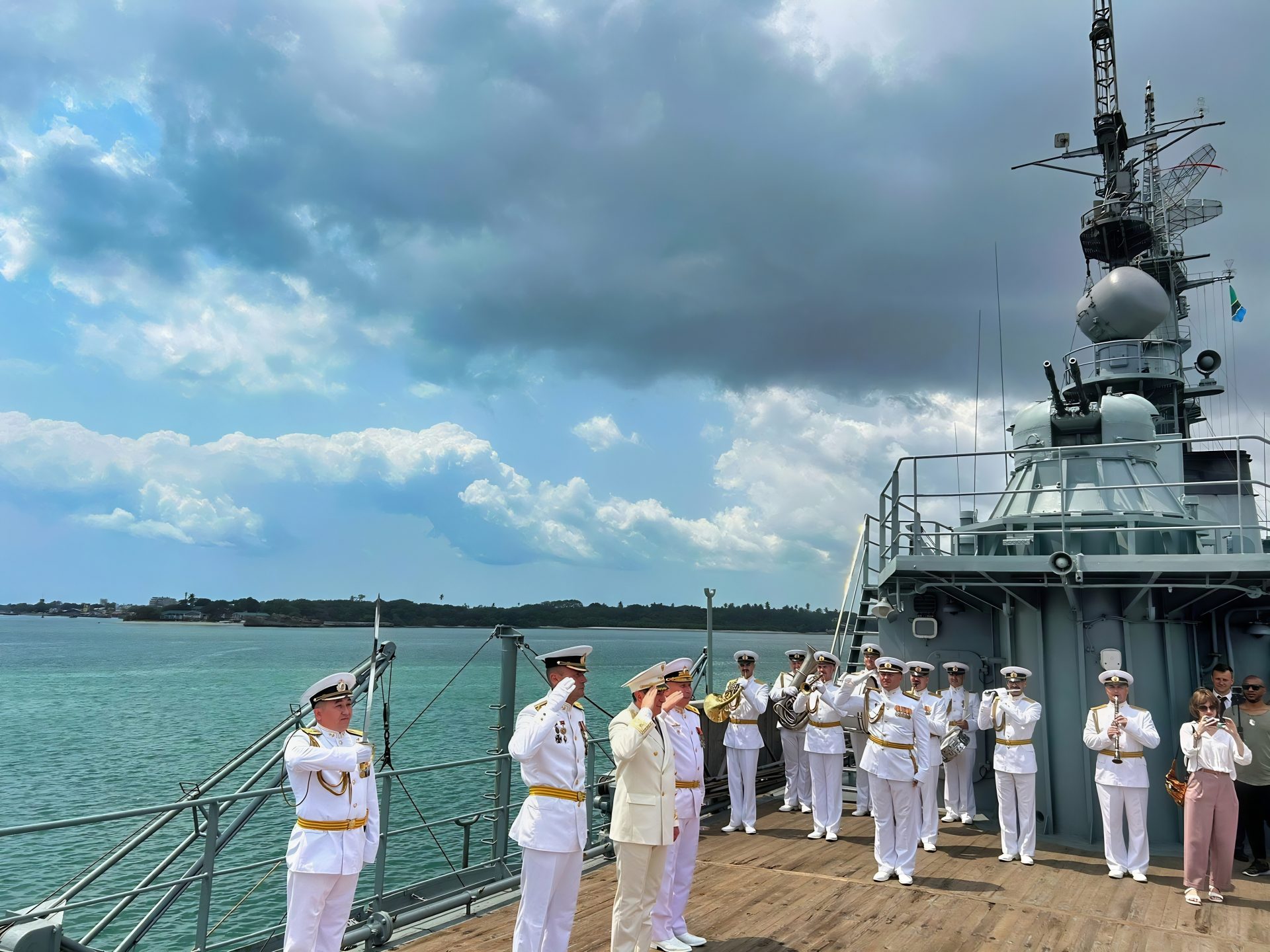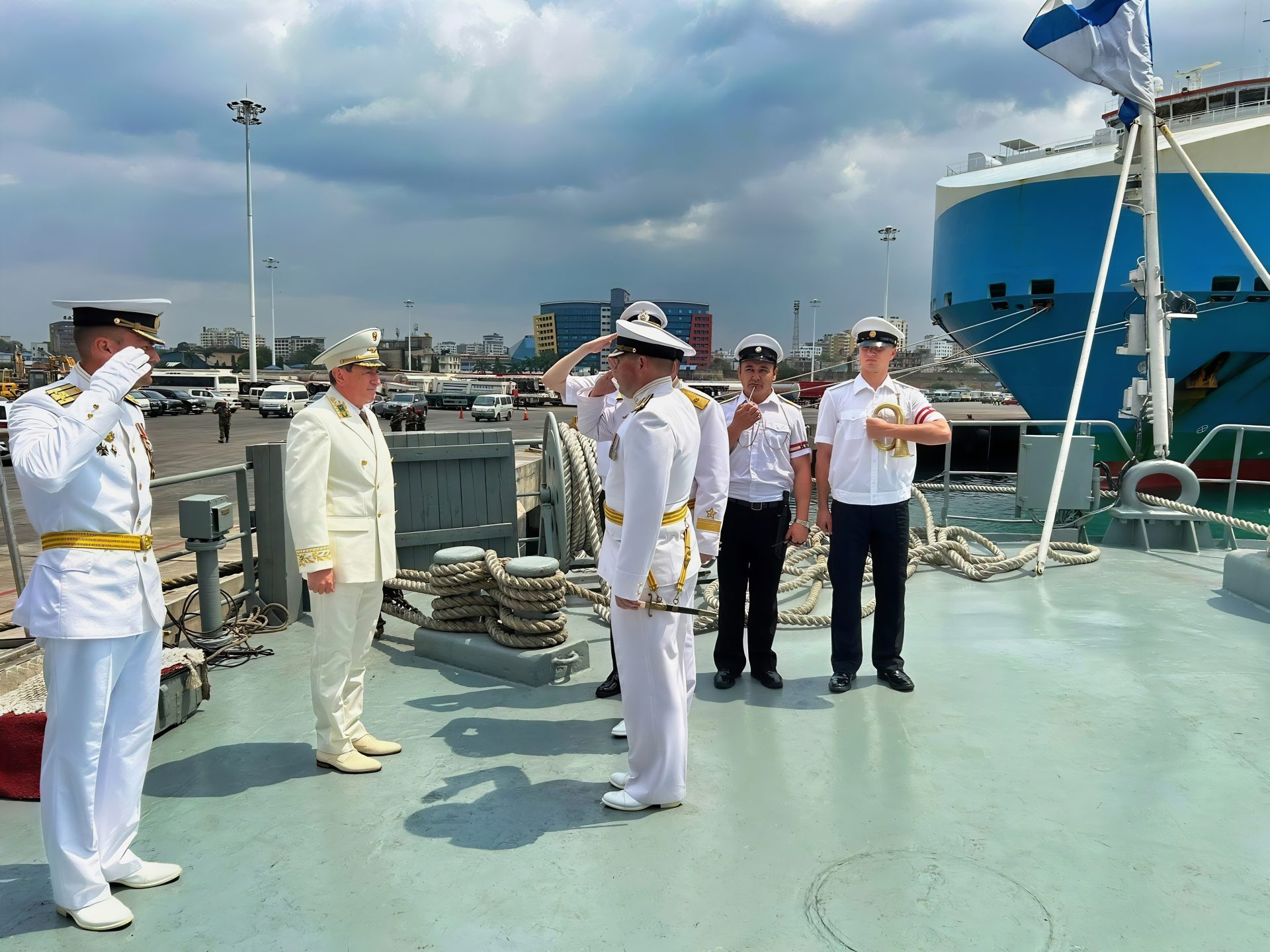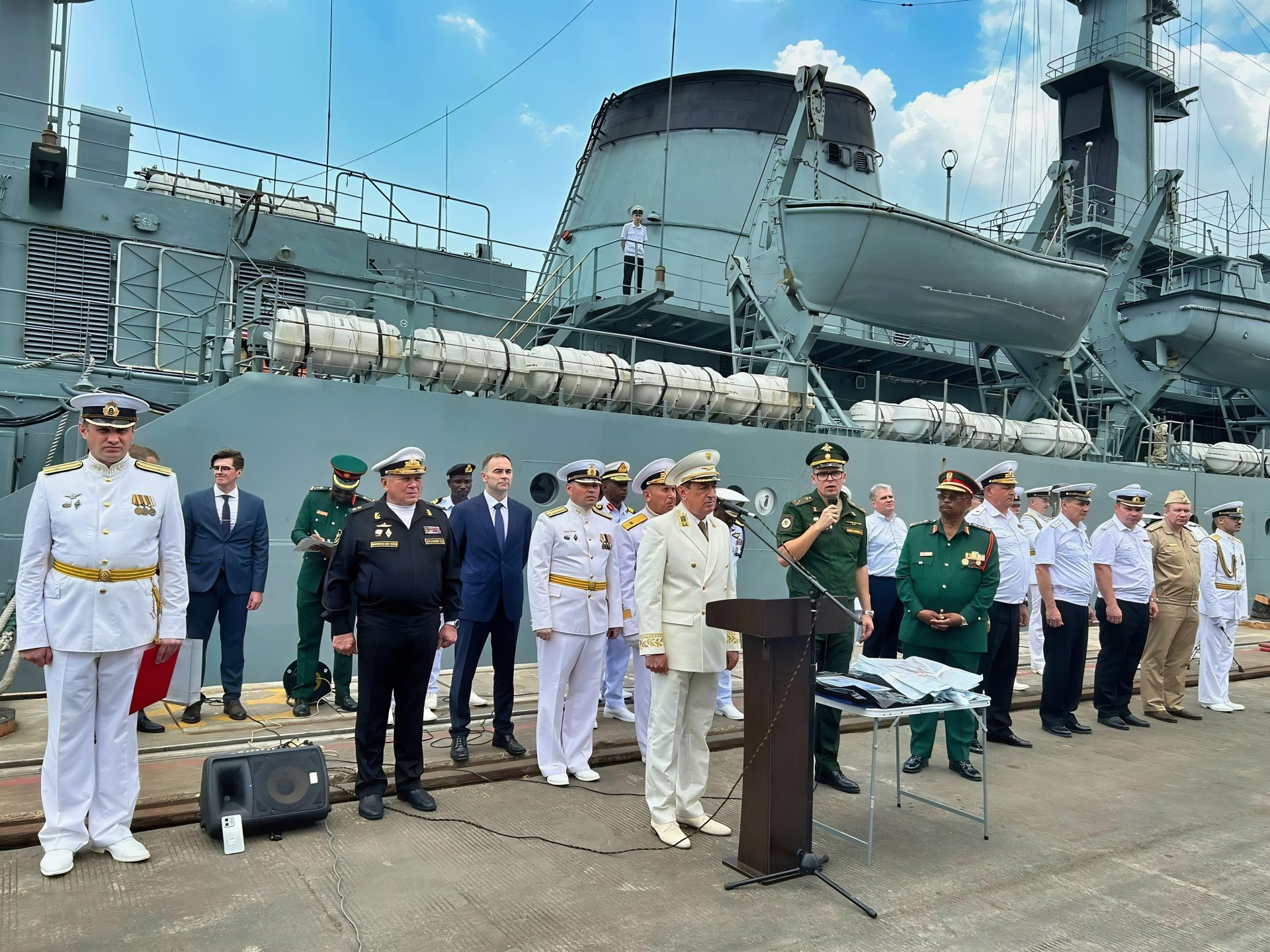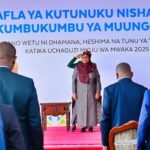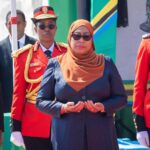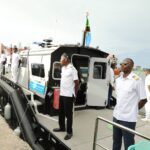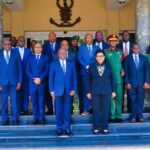Navigating New Waters: Russia’s Naval Partnership with Tanzania in the Indian Ocean
As the Russian training ship Smolny docks in Dar es Salaam, its arrival signals more than a routine port call—it represents a calculated step in Moscow’s strategic push into African maritime security and Tanzania’s ambitions to become an Indian Ocean power. This comprehensive analysis explores how Russian naval training is reshaping Tanzania’s maritime capabilities while navigating the complex currents of 21st-century geopolitics.
From the decks of the Smolny, where Tanzanian cadets master anti-piracy tactics and monsoon navigation, to the corridors of power where defence ministers weigh sovereignty against strategic partnerships, we examine:
-
The rebirth of Soviet-era ties through modern naval diplomacy and soft power
-
Tanzania’s pragmatic balancing act between Russian, Western, and Chinese influences
-
The real curriculum aboard Russia’s floating classroom – from celestial navigation to hybrid warfare
-
Regional implications for Kenya, Mozambique, and Indian Ocean security architectures
-
The billion-dollar question of how Tanzania can leverage foreign training without surrendering autonomy
With exclusive insights from Tanzanian naval officers, geopolitical analysts and maritime security experts, this deep dive reveals why Africa’s naval partnerships have become the newest frontier in global power competition—and how Tanzania is writing its own playbook for maritime sovereignty in turbulent times.
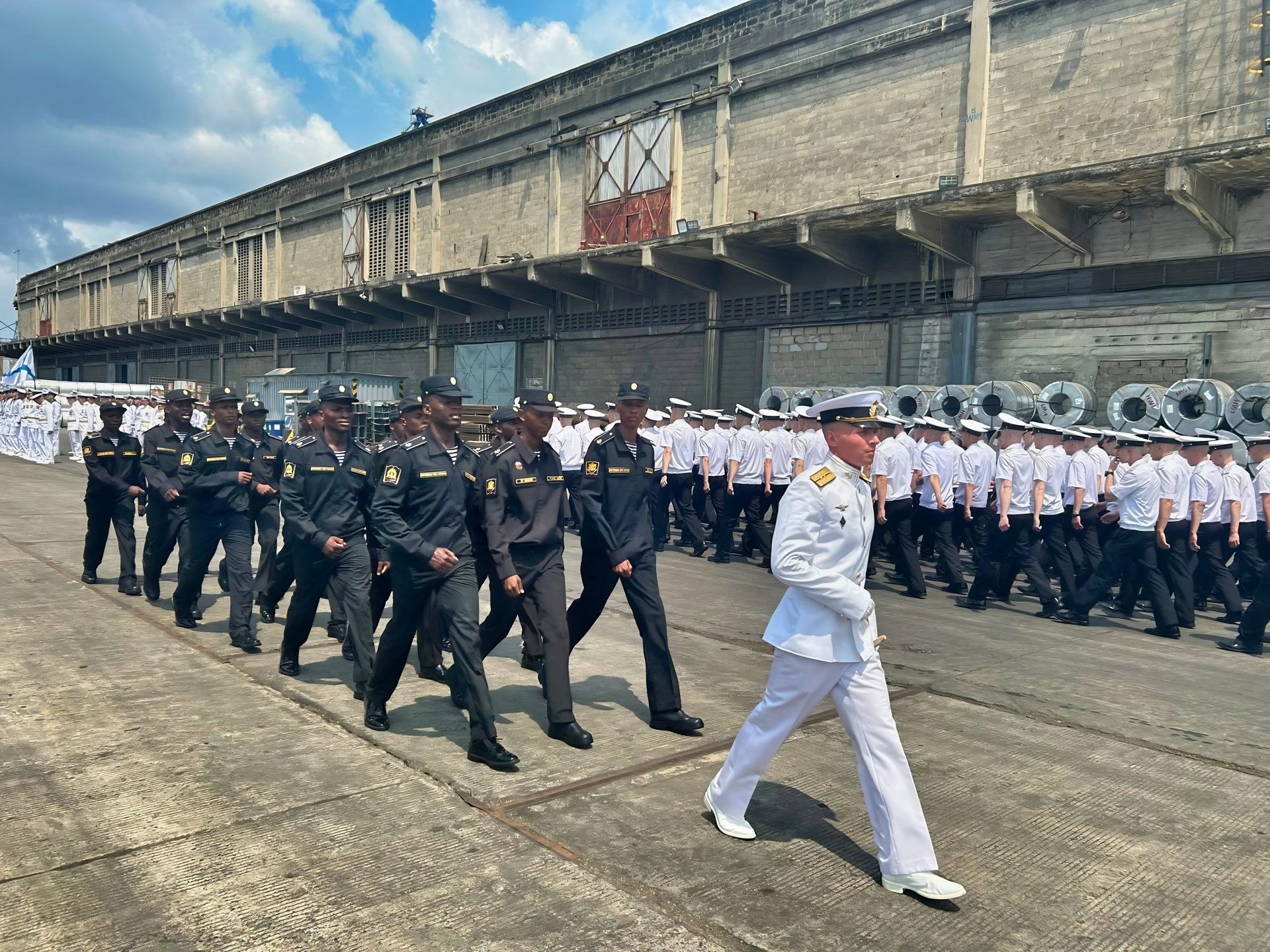
A Bridge of Maritime Friendship: Russian Training Ship Smolny Docks in Dar es Salaam
Introduction
On 16 August, the Russian Navy training ship Smolny glided into the bustling port of Dar es Salaam, marking another chapter in the long-standing military and maritime cooperation between Russia and Tanzania. This visit is more than just a diplomatic gesture—it is a hands-on educational mission, with Tanzanian sailors from the Jeshi la Wokovu wa Tanzania (JWTZ) honing their maritime skills aboard the vessel. As global geopolitics shift and Africa’s strategic importance grows, such exchanges underscore the deepening ties between Russia and African nations. But what does this collaboration mean for Tanzania’s naval capabilities, regional security, and international relations?
-
Old Friends, New Waters: The Enduring Military Ties Between Russia and Tanzania
“A river that flows for years never forgets its path.”
This Swahili adage aptly captures the long-standing military relationship between Russia and Tanzania—a partnership forged during the Cold War and now navigating the complex currents of 21st-century geopolitics. The arrival of the Russian training ship Smolny in Dar es Salaam is not just a routine port call; it is a reaffirmation of a decades-old alliance that has adapted to new strategic realities.
Soviet-Era Foundations: The Birth of a Strategic Partnership
Tanzania’s military ties with Russia trace back to the 1960s and 70s, when the East African nation, under founding President Julius Nyerere, embraced socialist policies and non-aligned movement principles. The Soviet Union, seeking to expand its influence in Africa, became a key benefactor:
-
Arms and Training: The USSR supplied Tanzania with MiG fighters, tanks, and naval vessels, while Tanzanian officers trained in Soviet military academies.
-
The 1978 Kagera War: When Uganda’s Idi Amin invaded Tanzania, Soviet-supplied weaponry played a crucial role in repelling the aggression, cementing trust in Moscow’s support.
-
Zanzibar’s Influence: The archipelago, with its historical ties to Oman and revolutionary socialist movements, became another bridge for Soviet-Tanzanian cooperation.
Post-Soviet Evolution: From Moscow to Modern Russia
The collapse of the USSR in 1991 left many African allies uncertain, but Russia, under Vladimir Putin, has actively sought to revive these relationships. Tanzania, balancing between Western and Eastern partnerships, has maintained defence cooperation with Moscow for several reasons:
-
Continuity of Trust: Many Tanzanian military leaders trained in Russia retain strong professional and personal ties, ensuring institutional memory.
-
Cost-Effective Expertise: Russian military training and equipment remain more affordable than Western alternatives, a key factor for Tanzania’s budget-conscious defence policy.
-
Non-Conditional Support: Unlike Western nations, Russia does not impose governance or human rights conditions on military aid—a pragmatic appeal for African partners.
Why Tanzania Still Chooses Russian Naval Training
In an era where global powers—China, the US, India, and the EU—are all vying for African military partnerships, Tanzania’s continued engagement with Russia is strategic:
-
Specialised Maritime Skills: Russia’s navy hain-depthep experience in both coastal defence and blue-water operations, crucial for Tanzania’s Indian Ocean security needs (anti-piracy, illegal fishing, and port security).
-
Geopolitical Balancing: While Tanzania maintains ties with the US (through exercises like Cutlass Express) and China (via port investments), Russian training offers an alternative, reducing over-reliance on any single power.
-
BRICS & Multilateralism: As Russia courts Global South nations via BRICS, Tanzania gains indirect benefits—access to broader diplomatic and economic networks.
A Counterargument: Is This Partnership Still Optimal?
Some analysts argue that Tanzania could benefit more from Western or Chinese naval partnerships, given their advanced technology and larger investment footprints in Africa. However:
-
Western training often comes with political strings.
-
Chinese naval aid is frequently tied to infrastructure debt.
-
Russia’s focus on practical military skills (rather than political alignment) keeps the partnership focused on Tanzania’s immediate defence needs.
Conclusion: Sailing Forward with an Old Compass
The Smolny’s visit is more than symbolic—it is a reminder that Tanzania and Russia’s military relationship, much like an enduring river, has carved its course through changing landscapes. While new partnerships emerge, the trust, affordability, and specialised expertise Russia offers ensure this alliance remains relevant.
Yet, as global competition intensifies, Tanzania must navigate carefully—leveraging Russian training while diversifying its defence ties to safeguard its sovereignty. After all, in the words of another Swahili proverb: “Maji ya kifufu ni bahari ya chini” (The water beneath the waves is still the ocean)—meaning, beneath the surface of diplomacy, the deep currents of national interest always remain.
-
2. Two Anchors, One Harbour: How Russian and Chinese Naval Engagements in Africa Compare
“When two elephants wrestle, the grass suffers; when they cooperate, the land flourishes.”
This African proverb captures the delicate balance Tanzania and other African nations must strike as both Russia and China expand their naval footprints across the continent. While the recent visit of Russia’s Smolny highlights enduring military ties, China’s growing maritime presence—from Djibouti to Dar es Salaam—presents a different model of engagement. Understanding how these two powers operate in Africa’s waters is crucial for grasping Tanzania’s strategic calculus.
1. Strategic Objectives: Security vs. Economics
Russia’s Approach:
-
Focus: Military training, arms sales, and tactical partnerships.
-
Tanzania Case: The Smolny’s visit is purely defence-oriented, offering JWTZ sailors hands-on maritime skills without direct economic strings.
-
Broader Africa Role: Russia positions itself as a security guarantor, especially in unstable regions (e.g., Mali, Central African Republic), often leveraging private military companies like Wagner.
China’s Approach:
-
Focus: Port investments, infrastructure loans, and “soft” naval diplomacy.
-
Tanzania Case: The Bagamoyo megaport project (though stalled) and China’s role in upgrading Dar es Salaam’s harbour highlight its economic-first strategy.
-
Broader Africa Role: China’s first overseas military base in Djibouti (2017) signals long-term naval ambitions, framed as protecting trade routes under the “String of Pearls” strategy.
Key Difference:
-
Russia offers immediate military value; China provides long-term economic leverage with potential dual-use (civilian/military) port access.
2. Training vs. Infrastructure: Two Paths to Influence
Russia’s Naval Training Model:
-
Hands-on skill transfer: Tanzanian cadets learn ship handling, anti-piracy tactics, and naval engineering—directly applicable to regional threats.
-
Legacy Advantage: Many Tanzanian officers trained in Russia/USSR since the 1970s trust its methods.
China’s Infrastructure-for-Access Model:
-
Ports as Trojan Horses? Chinese-built harbours (e.g., Kenya’s Lamu, Angola’s Lobito) often include clauses allowing PLA Navy access during crises.
-
Training with Strings Attached: While China offers scholarships to its naval academies, recipients often return as advocates for Chinese equipment purchases.
Tanzania’s Balancing Act:
-
Russia = Skills.
-
China = Infrastructure.
-
Smart hedging: Tanzania benefits from both without overcommitting—e.g., allowing Russian training while cautiously negotiating Bagamoyo’s terms.
3. Geopolitical Implications: The West’s Uneasy Watch
Russia’s Play:
-
Wins loyalty by framing itself as an anti-Western bulwark (e.g., supplying arms when Western nations impose embargoes).
-
Uses military ties to secure UN votes (e.g., Tanzania’s neutrality on Ukraine reflects Moscow’s influence).
China’s Play:
-
Leverages economic dependence to sway policy (e.g., African nations avoiding criticism of Beijing’s human rights record).
-
Naval visits to Dar es Salaam are rare but growing—a 2022 PLA Navy stopover signalled quiet interest.
Western Concerns:
-
Russia is considered destabilising (e.g., Wagner Group’s shadowy role in conflicts).
-
China is viewed as a “debt trap” strategist (e.g., Sri Lanka’s Hambantota port takeover).
-
Tanzania, however, has avoided both pitfalls—so far.
4. The Future: Will Tanzania Have to Choose?
“You cannot sit on two boats at once.”
As competition heats up, Tanzania’s neutrality may face strains:
-
If Russia deepens its African naval presence, could Tanzania host more frequent drills—or even a logistics hub?
-
If China revives Bagamoyo, will it demand preferential naval access, as in Djibouti?
Optimistic Scenario: Tanzania continues leveraging both for maximum benefit—Russian training to deter piracy, Chinese ports to boost trade.
Pessimistic Scenario: Escalating US-China-Russia rivalry forces Tanzania into uncomfortable alignment.
Conclusion: Navigating the New Great Game
The Smolny’s visit and China’s port ambitions represent two sides of Africa’s evolving maritime strategy. For Tanzania, the challenge is to extract value from both without surrendering sovereignty.
As the Swahili saying goes, “Mwenye kujua nyumba ya majini, huingia kwa macho mepesi” (“He who knows the genie’s house enters with light steps”). Tanzania must tread carefully—welcoming Russian expertise and Chinese investment, but always on its own terms.
The waves of the Indian Ocean will test whether this balancing act holds. One thing is certain: in the contest for Africa’s waters, Tanzania intends to be the sailor—not the sail.
3. The Smolny: Russia’s Floating Classroom Shapes Tanzania’s Naval Future
“Knowledge is like the ocean—you can take from it endlessly, yet it never runs dry.”
This Swahili adage encapsulates perfectly the essence of the Russian Navy’s training ship Smolny, which docked in Dar es Salaam on 16 August. More than just a vessel, the Smolny serves as a mobile academy, where Tanzanian cadets from the Jeshi la Wokovu wa Tanzania (JWTZ) immerse themselves in the art of maritime warfare, navigation, and engineering. As Tanzania seeks to bolster its naval capabilities in an increasingly contested Indian Ocean, this floating classroom represents a critical link in the chain of Russia-Tanzania defence cooperation.
1. The Smolny: A Vessel Steeped in History
Origins & Design:
-
Commissioned in 1976, the Smolny is a Project 887 training ship, designed to groom the next generation of naval officers.
-
Displacement: 7,000 tonnes | Length: 138 metres | Speed: 18 knots
-
Capacity: Hosts up to 300 cadets and 150 crew, with classrooms, simulators, and live drill decks.
Operational Pedigree:
-
For nearly five decades, the Smolny has trained cadets not just from Russia, but from allied nations—including Vietnam, Angola, and now Tanzania.
-
Its voyages often double as diplomatic missions, strengthening ties with Global South partners.
2. Inside the Floating Classroom: What Tanzanian Cadets Learn
The Smolny offers a hands-on curriculum, blending theory with real-world application:
A. Maritime Warfare Tactics
-
Anti-Piracy Drills: With piracy resurging in the Western Indian Ocean, Tanzanian sailors train in boarding operations, threat assessment, and crisis response.
-
Gunnery Practice: Cadets fire the ship’s AK-630 close-in weapon systems (CIWS), learning to neutralise fast-attack craft and drones.
B. Navigation & Seamanship
-
Celestial Navigation: While GPS dominates modern sailing, the Smolny emphasises traditional techniques—a vital skill if electronic systems fail.
-
Monsoon Readiness: Cadets study the Indian Ocean’s treacherous seasonal winds, critical for Tanzania’s monsoon-vulnerable coastline.
C. Marine Engineering
-
Engine Room Simulations: Trainees troubleshoot diesel engine failures, a common issue in Tanzania’s ageing fleet.
-
Damage Control: Flooding and firefighting drills prepare crews for emergencies at sea.
3. Why Russian Training Stands Out
Compared to Western or Chinese programmes, Russia’s approach offers Tanzania unique advantages:
A. Combat-Proven Methods
-
Russia’s navy has real-world experience in hybrid warfare (e.g., Black Sea operations), offering insights into asymmetric threats.
-
Example: Electronic warfare training—a growing need as drone attacks plague regional shipping lanes.
B. Affordability & No Strings Attached
-
Unlike Western courses (which often require alignment with NATO standards), Russian training focuses on practical skills without political conditions.
-
Cost: Tanzania pays minimally; the Smolny’s visit is partly subsidised by Moscow’s defence diplomacy budget.
C. Cultural Familiarity
-
Many Tanzanian officers trained in Russia during the Soviet era, creating a generational bridge.
-
Language: Basic Russian is taught onboard, but instruction is often in English or via Swahili-speaking interpreters.
4. Counterpoint: Are There Gaps in the Training?
Critics argue:
-
Outdated Tech: The Smolny lacks cutting-edge systems like AEGIS combat suites used by Western navies.
-
Limited Fleet Integration: Skills learned on Russian ships may not seamlessly transfer to Tanzania’s mixed fleet (which includes Chinese and European vessels).
Tanzania’s Pragmatic View:
-
“Better to master an old rifle than to fumble with a new one.”
-
The focus is on foundational skills—maintenance, navigation, and small-team tactics—that apply across platforms.
5. The Bigger Picture: Tanzania’s Naval Ambitions
The Smolny’s visit aligns with Tanzania’s 2021–2026 Naval Modernisation Plan, which prioritises:
-
Coastal Surveillance: Curbing illegal fishing (costing Tanzania $300M annually).
-
Regional Leadership: Partnering with Kenya and Mozambique on anti-piracy patrols.
-
Port Security: Safeguarding Dar es Salaam, a gateway for 90% of the nation’s trade.
Conclusion: A Voyage of Mutual Benefit
As the Smolny departs Dar es Salaam, it leaves behind more than just wake in the harbour—it leaves a cadre of Tanzanian sailors better equipped to defend their waters. In the words of a Zanzibari proverb, “Maji ya kulevya huanzia mtama” (“The ocean’s depth begins at the shore”). For Tanzania, the Smolny represents those first steps into deeper maritime competence, with Russia as a willing tutor.
Yet, the true test lies ahead: Can Tanzania synthesise Russian training, Chinese infrastructure, and Western partnerships into a cohesive naval strategy? If so, it may yet become the Indian Ocean’s next maritime success story.
4. Anchoring Security: How Russian Naval Training Fortifies Tanzania’s Maritime Defences
“A single canoe cannot patrol the entire shoreline, but a fleet can guard the nation.”
This Tanzanian proverb captures the essence of the country’s naval modernisation efforts as it faces growing maritime threats in the Indian Ocean. The arrival of Russia’s training ship Smolny in Dar es Salaam represents more than ceremonial diplomacy – it’s a strategic investment in addressing Tanzania’s most pressing maritime security challenges. From the pirate-infested waters off Mtwara to the illegal fishing operations draining Tanzania’s blue economy, Russian naval expertise is helping to transform the Jeshi la Wokovu wa Tanzania (JWTZ) into a more capable maritime force.
1. Tanzania’s Maritime Security Challenges
A. Piracy & Armed Robbery at Sea
-
Hotspot: The Mozambique Channel has seen a 40% increase in piracy incidents since 2020 (IMB reports)
-
Local Impact: Tanzanian dhows frequently hijacked for use as “motherships” in regional piracy operations
-
Russian Training Solution:
-
Boarding party tactics practised aboard Smolny
-
Small boat interception drills using Russian RHIB techniques
-
Night-time operations training for coastal surveillance
-
B. Illegal, Unreported & Unregulated (IUU) Fishing
-
Economic Toll: Estimated $300 million annual loss (FAO data)
-
Perpetrators: Mostly Chinese, South Korean and European trawlers
-
Russian Countermeasures:
-
Vessel identification systems training
-
Maritime patrol coordination exercises
-
Evidence-gathering protocols for prosecutions
-
C. Regional Security Cooperation
-
Critical Waterways: Tanzania borders three major shipping lanes
-
Russian Strategic Value:
-
Joint exercises with Mozambique (2022) modelled on Russian naval doctrine
-
Intelligence-sharing frameworks based on Russian naval protocols
-
2. Case Studies: African Navies Transformed Through Foreign Partnerships
A. Nigeria: The United Kingdom’s Impact
-
Partnership: Royal Navy training since 2013 under the UK’s Security, Defence, and Development programme
-
Results:
-
60% reduction in Gulf of Guinea piracy by 2023
-
Establishment of Deep Blue Project maritime security architecture
-
B. Mozambique: The Russian-Indian Collaboration
-
Intervention: Russian naval advisors + Indian patrol boats (2018-2023)
-
Outcomes:
-
Cabo Delgado insurgency containment
-
New maritime domain awareness centre in Pemba
-
C. Egypt: The Comprehensive American Upgrade
-
Investment: $1.3 billion in naval systems since 2015
-
Capability Leap:
-
Advanced Mistral-class amphibious operations
-
Integration into Red Sea security frameworks
-
3. Why the Russian Model Works for Tanzania
A. Cost-Effective Capacity Building
-
Comparative Costs:
-
Russian training: $15,000 per cadet (annual)
-
Western alternatives: $45,000+ (with political conditions)
-
B. Specialised Tropical Maritime Expertise
-
Black Sea Parallels: Russia’s experience in warm-water operations translates well to Tanzanian conditions
-
Maintenance Focus: Emphasis on keeping older vessels operational – crucial for Tanzania’s ageing fleet
C. Non-Aligned Strategic Benefits
-
Geopolitical Flexibility: Unlike Western training, doesn’t limit Tanzania’s partnerships with China or others
-
UN Voting Alignment: Russia supports Tanzania’s stance on Indian Ocean governance issues
4. The Road Ahead: From Training to Transformation
2024-2030 Naval Development Plan:
-
Fleet Modernisation: Integrating Russian-trained crews with new patrol vessels
-
Coastal Radar Network: Russian-assisted installation planned for 2025
-
Regional Leadership: Positioning Tanzania as Indian Ocean security hub
Potential Pitfalls:
-
Over-reliance on single training methodology
-
Technology transfer limitations under Western sanctions on Russia
Conclusion: Navigating Towards Maritime Sovereignty
As the Smolny‘s Tanzanian graduates take their posts aboard JWTZ vessels, they embody another Swahili adage: “Maji ya chumvi hayachungiwi na mkono mmoja” (“Saltwater cannot be contained by one hand alone”). Tanzania’s maritime security, like the ocean itself, requires multiple layers of protection.
The Russian training partnership provides crucial tools, but the ultimate test will be Tanzania’s ability to blend these with other partnerships while maintaining strategic independence. In an era where African waters are becoming the new battleground for global influence, Tanzania’s naval evolution could determine whether it becomes a security leader or merely another player in great power rivalries.
5. The Tide of Influence: Russia’s Naval Diplomacy in Tanzania and the Great Power Contest
“When elephants fight, the grass suffers; when they court favour, the land must choose wisely.”
This Swahili proverb reflects Tanzania’s delicate position as global powers vie for influence in African waters. The arrival of Russia’s training ship Smolny in Dar es Salaam is not merely about naval education—it is a strategic move in Moscow’s broader campaign to expand its African footprint through military diplomacy. As Western nations and China compete for maritime partnerships across the continent, Tanzania’s choice to deepen collaboration with Russia carries significant geopolitical weight.
1. Russia’s Military Diplomacy in Africa: A Resurgent Strategy
A. The Soviet Legacy and Modern Revival
-
Cold War Foundations: Russia inherits Soviet-era ties with Tanzania dating back to the 1960s, when Moscow supported liberation movements and trained African officers.
-
Post-2014 Pivot: After Western sanctions over Ukraine, Russia intensified outreach to Africa, offering arms, training, and security partnerships as alternatives to Western aid.
-
Key Tools of Influence:
-
Naval Visits: Ships like Smolny serve as floating embassies, showcasing Russian capabilities.
-
Private Military Companies (PMCs): Wagner Group’s presence in Mozambique and Libya demonstrates Russia’s hybrid warfare approach.
-
UN Diplomacy: Russia backs African nations in international forums, earning political goodwill.
-
B. Why Tanzania? Strategic Value in the Indian Ocean
-
Gateway to East Africa: Tanzania’s 1,424 km coastline is critical for regional trade and security.
-
Resource Security: Russia eyes Tanzania’s offshore gas reserves and mineral exports.
-
Diplomatic Neutrality: Tanzania’s non-aligned stance makes it an ideal partner for Moscow to counter Western dominance.
2. Russian vs. Western Training Programmes: A Tanzanian Calculus
A. The Russian Advantage
-
No Political Strings Attached
-
Unlike the EU or US, Russia does not demand governance reforms or human rights conditions.
-
Example: The US Africa Maritime Law Enforcement Programme (AMLEP) requires anti-corruption commitments.
-
-
Cost-Effectiveness
-
Russian training is heavily subsidised; Tanzania pays minimal costs compared to Western courses.
-
Data Point: A 6-month US Coast Guard course costs $50,000 per officer; Russian equivalents are 60% cheaper.
-
-
Combat-Relevant Skills
-
Focus on asymmetric warfare (anti-piracy, coastal defence) rather than NATO-standard fleet operations.
-
B. The Western Counteroffer
-
Advanced Technology Transfer
-
The UK’s Cutlass Express exercises introduce cutting-edge maritime surveillance systems.
-
The US provides access to the SeaVision global ship-tracking network.
-
-
Multilateral Integration
-
Western programmes connect Tanzania with regional allies (Kenya, Seychelles) under shared protocols.
-
-
Soft Power Perks
-
English-language training, which aligns with Tanzania’s international trade needs.
-
C. Tanzania’s Pragmatic Choice
-
Diversification Over Dependence: By engaging both Russia and the West, Tanzania avoids over-reliance on any single power.
-
Case in Point: While JWTZ officers train on Smolny, Tanzania also participates in US-led Obangame Express anti-piracy drills.
3. The Bigger Picture: Africa’s Shifting Alliances
A. Russia’s African Footprint Beyond Tanzania
-
Mozambique: Wagner PMCs assisted counterinsurgency operations (2019–2023).
-
Sudan: Russia seeks a Red Sea naval base in exchange for arms deals.
-
Central African Republic: Russian advisors oversee presidential security.
B. Western Countermoves
-
France’s Exit & Re-engagement: Withdrew from Mali but increased cooperation with Côte d’Ivoire and Ghana.
-
US AFRICOM Expansion: New maritime initiatives in Kenya and Somalia.
C. China’s Quiet Naval Push
-
Djibouti Base: PLA Navy’s only overseas military installation.
-
Port Investments: Tanzania’s Bagamoyo project (though stalled) hints at future dual-use potential.
4. Risks and Opportunities for Tanzania
A. The Benefits of Russian Ties
-
Sovereignty Preservation: Less pressure to align with Western policies.
-
Bargaining Power: Leverages Russian offers to negotiate better terms with other partners.
B. Potential Pitfalls
-
Sanctions Contagion: US CAATSA sanctions could complicate arms deals.
-
Technology Gaps: Russian systems may not integrate with Western-donated assets.
Conclusion: Navigating Uncharted Waters
“A wise captain reads the stars, but never ignores the currents beneath.”
Tanzania’s embrace of Russian naval training reflects a pragmatic, non-aligned strategy in an era of great power competition. While the Smolny delivers immediate tactical benefits, the long-term challenge will be balancing these gains with broader diplomatic and technological partnerships.
As global tensions escalate, Tanzania’s ability to extract value from both Russian and Western collaborations—without surrendering its sovereignty—will determine whether it emerges as a maritime leader or becomes another pawn in the new Great Game for Africa’s oceans.
6. From Classroom to Bridge: The Transformative Onboard Training Aboard Russia’s Smolny
“A sailor is not made in calm waters, but in the school of waves and wind.”
This Tanzanian maritime proverb encapsulates perfectly the rigorous training experience of JWTZ cadets aboard the Russian training ship Smolny. As the vessel cuts through the Indian Ocean’s swells, Tanzanian sailors undergo a comprehensive transformation – from green recruits to competent naval professionals. The training curriculum, honed over decades of Russian naval tradition, equips Tanzania’s maritime forces with crucial skills to protect the nation’s 1,424 km coastline and vital offshore resources.
Core Curriculum: The Smolny’s Training Modules
1. Navigation & Seamanship
-
Celestial Navigation: Cadets learn to use sextants and star charts, preserving this vital skill even in the GPS age
-
Monsoon Navigation: Specialized training for Tanzania’s challenging seasonal weather patterns
-
Electronic Systems: Operation of Russian-made navigation radars (Fregat-M2EM) and chart plotters
“The stars don’t lie – our Russian instructors taught us that,” recalls Lieutenant Jamal Hassan, a 2021 graduate now serving on Tanzania’s patrol vessel TNS Fatundu.
2. Maritime Warfare & Security
-
Anti-Piracy Drills: Boarding procedures and non-lethal deterrent tactics
-
Weapons Training:
-
AK-630 close-in weapon systems (simulated)
-
PKM machine gun deployment on fast attack craft
-
-
Electronic Warfare Basics: Detection and countermeasures for drone threats
3. Engineering & Damage Control
-
Diesel Engine Maintenance: Critical for Tanzania’s fleet of aging patrol boats
-
Firefighting Simulations: Live exercises in the ship’s dedicated training compartment
-
Flood Containment: Using Russian-designed collision mats and pump systems
The Russian Training Methodology
What sets the Smolny experience apart is its:
-
Stress Training Approach
-
48-hour continuous drills simulating battle conditions
-
Sleep deprivation exercises to build resilience
-
Cross-Departmental Rotation
-
Cadets spend time in navigation, engineering, and combat roles
-
Creates officers with holistic understanding of ship operations
-
Cultural Exchange Elements
-
Russian language basics taught alongside technical skills
-
Shared meals creating bonds between Tanzanian and Russian crews
Testimonials: Tanzanian Voices from the Smolny
Chief Petty Officer Asha Rajab (2019 Graduate):
“The Russian way is harsh but effective. When we had to repair an engine blindfolded during drills, I thought it was impossible. Now I can troubleshoot our patrol boat’s engines by sound alone.”
Ensign Daudi Mwambene (Currently Training):
“The night navigation exercises changed everything for me. Tanzania’s coast looks entirely different in the dark – the Russians showed us how to ‘read’ the water’s movement.”
Comparative Advantage Over Western Programmes
While Western training tends to focus on:
✔ High-tech systems operation
✔ Rules of engagement theory
The Russian approach emphasizes:
✔ Mechanical reliability under stress
✔ Improvisation with limited resources
✔ Small-unit leadership in crisis
“What good is advanced radar if your generator fails during a storm?” notes Commander Yuri Petrov, a Smolny instructor with African deployment experience.
Challenges & Adaptations
Tanzanian cadets sometimes struggle with:
-
Russia’s extreme climate during winter training segments
-
Different maintenance philosophies (Russian vs. Chinese equipment in Tanzania’s fleet)
The programme has adapted by:
-
Increasing Swahili-language technical manuals
-
Incorporating familiarization with Chinese systems
Conclusion: Building Tanzania’s Naval Future
As another class of Tanzanian sailors completes their Smolny training, they embody another local saying: “Maji hufuata mkondo, lakini baharia hujenga mto wake” (“Water follows the current, but a sailor charts his own course”).
The skills learned aboard this floating academy will ripple through Tanzania’s maritime forces for decades. While the ship may be Russian, the knowledge gained is becoming profoundly Tanzanian – adapted to local conditions and needs. In an era where African maritime security is increasingly vital, this transfer of expertise represents one of the most practical forms of international cooperation.
7. More Than Warships: How Russia’s Naval Diplomacy Wins Tanzanian Hearts and Minds
“A ship’s wake lingers long after its sails have disappeared”
This Swahili adage captures perfectly the enduring impact of Russia’s naval diplomacy in Tanzania. While the Smolny‘s guns may draw attention, it’s the softer elements of these visits – the cultural exchanges, educational opportunities, and personal connections – that truly cement long-term partnerships between Dar es Salaam and Moscow.
1. The Anatomy of Naval Soft Power
A. Floating Embassies of Goodwill
-
Crew Cultural Exchanges: Russian sailors participate in:
-
Swahili language lessons
-
Football matches with local teams
-
Joint musical performances (notably the Russian-Tanzanian navy band concert in 2022)
-
-
Community Outreach: Medical teams from visiting ships often conduct:
-
Free dental clinics in port communities
-
Maritime safety workshops for local fishermen
-
B. The Education Pipeline
Russia’s multi-tiered approach:
-
Short-term: Onboard training during port visits
-
Medium-term: 6-month courses at St. Petersburg naval academies
-
Long-term: Full degree programmes for Tanzanian officers
“I went to Russia for torpedoes but returned with Tolstoy,” jokes Lieutenant Ali Mwinyi, referencing the mandatory Russian literature classes.
2. Russia’s Playbook: Education as Strategic Investment
A. The Alumni Network Effect
-
Over 300 Tanzanian naval officers trained in Russia since 2010
-
Graduates now occupying key positions:
-
40% of Tanzania’s naval command staff
-
60% of maritime training instructors
-
B. Curriculum Beyond Combat
While Western programmes focus narrowly on military skills, Russian training includes:
-
Russian language certification
-
Cross-cultural communication
-
Political ideology components (subtly emphasizing multipolar world views)
C. The “Second Generation” Strategy
-
Children of Tanzanian officers offered scholarships at Russian civilian universities
-
Creates familial ties to Russia that last decades
3. Comparative Soft Power Approaches
| Aspect | Russian Model | Western Alternatives |
|---|---|---|
| Language Training | Intensive Russian + English | English-only focus |
| Cultural Exposure | Full immersion in Russian life | Limited to military contexts |
| Post-Service Benefits | Alumni networks + trade opportunities | Less structured follow-up |
4. Tanzania’s Strategic Calculations
Why This Appeals to Dar es Salaam:
-
Non-Transactional Relationship: Unlike Chinese infrastructure deals with strings attached
-
Prestige Factor: Russian training carries weight in African security circles
-
Balancing Act: Complements rather than replaces Western partnerships
Potential Risks:
-
Graduates sometimes struggle to adapt Russian doctrine to Tanzanian realities
-
Concerns about over-dependence on Russian systems
5. The Long Game: Russia’s African Ambitions
This soft power strategy serves Moscow’s broader goals:
-
UN Voting Bloc: Tanzania’s support on key issues
-
Arms Market Expansion: 75% of Tanzanian naval equipment now Russian-made
-
Counter-Western Influence: Creating non-aligned partners in strategic waters
“They’re not just training sailors – they’re creating Russian-speaking Tanzanian naval families,” observes Dr. Fatma Akil of Dar es Salaam University’s International Relations Department.
Conclusion: The Tide of Influence
As another Tanzanian cadet class boards the Smolny, they’re participating in more than just a training exercise – they’re becoming links in a chain of Russo-Tanzanian relations that stretches back to the Cold War and forward into an uncertain multipolar future.
The wisdom of Mwalimu Nyerere seems prescient: “When the oceans of change rage, build bridges, not walls.” Russia’s naval diplomacy understands this profoundly – that today’s cadet exchanges become tomorrow’s admirals’ alliances.
For Tanzania, the challenge remains, balancing these deepening ties with Russia against its other international relationships. But one thing is certain – the soft power currents set in motion by visits like the Smolny‘s will continue shaping Tanzania’s maritime future long after the ship has sailed.
8. Two Sides of the Coin: Examining the Risks in Tanzania’s Russian Naval Partnership
“When you borrow a neighbour’s net, you may catch fish—but the mesh pattern remains his.”
This Tanzanian proverb encapsulates the central dilemma facing Dar es Salaam as it deepens naval cooperation with Moscow. While the Smolny‘s training programmes offer immediate benefits, growing Western alarm and legitimate concerns about long-term dependencies invite careful scrutiny of this burgeoning partnership.
1. The Dependency Dilemma
A. Technical Lock-In Risks
-
Fleet Standardisation: 78% of Tanzania’s operational naval assets now Russian/Soviet-origin
-
Maintenance Complexities:
-
Spare parts availability impacted by Ukraine war sanctions
-
Only 3 Tanzanian engineers certified to repair Klimov gas turbines
-
B. Doctrine Dependence
-
Cultural Mismatch: Russian “top-down” command structures vs. Tanzania’s more consultative tradition
-
Case Example: 2021 incident when Russian-trained crews struggled to integrate with US-donated patrol boats during joint exercises
C. The Generational Trap
-
Each cohort of Russian-trained instructors produces more Russian-oriented graduates
-
Creates institutional inertia resistant to diversification
2. Western Scepticism: Security Concern or Great Power Envy?
A. Legitimate Security Apprehensions
-
Wagner Precedent:
-
Russia’s PMC playbook in Mozambique/CAR creating instability
-
Tanzanian assurances of “training-only” cooperation questioned
-
-
Technology Transfer Risks:
-
Potential dual-use applications of naval training
-
US AFRICOM warnings about Russian electronic warfare systems data collection
-
B. Geopolitical Rivalry Factors
-
Arms Market Protectionism: Western objections coinciding with French/UK attempts to sell patrol vessels
-
UN Voting Influence: Russia gaining Tanzanian support on Ukraine-related votes
“When the crocodile warns about river dangers, ask which bank it’s guarding” – Tanzanian diplomat speaking anonymously
3. Tanzania’s Mitigation Strategies
A. Diversification Efforts
-
Parallel training programmes with:
-
India (coastal surveillance)
-
Japan (search-and-rescue)
-
US (maritime law enforcement)
-
B. Localisation Policies
-
Mandating 30% local content in naval procurement
-
Establishing Zanzibar Maritime Academy as counterbalance
C. Strategic Ambiguity
-
Carefully avoiding joint Russia-China naval exercises
-
Declining participation in Russia’s proposed Indian Ocean task force
4. Case Study: Mozambique’s Cautionary Tale
2017-2022 Experience Shows:
-
Initial benefits of Russian training in combating insurgents
-
Subsequent over-reliance led to:
-
Wagner Group mission creep
-
Complicated relations with SADC allies
-
Equipment compatibility issues with regional partners
-
Tanzania’s Key Takeaways:
-
Maintain clear contractual boundaries
-
Insist on technology transfer clauses
-
Preserve regional partnership options
5. The Sanctions Shadow
Potential Secondary Effects:
-
Complicated refuelling for Russian-trained ships in Western-aligned ports
-
SWIFT restrictions creating payment hurdles for spare parts
-
Insurance challenges for Russian-equipped vessels
Conclusion: Navigating the Geopolitical Narrows
As Tanzania charts its course between great powers, another local adage comes to mind: “The wise fisherman mends nets with many threads.” The challenge for Dar es Salaam lies in benefiting from Russian expertise while avoiding the trap of singular dependence.
The Smolny‘s training programmes undoubtedly enhance Tanzania’s maritime capabilities in the short term. Yet the true test will be whether these partnerships ultimately serve Tanzania’s sovereign interests—or subtly reshape them to serve Moscow’s strategic ends in Africa’s new Great Game.
In this era of competing influences, Tanzania’s naval leadership must ask not just what skills their sailors are acquiring, but what long-term obligations and alignments they might be unconsciously adopting. The answers will determine whether Tanzania emerges as a truly independent maritime power or becomes what strategists fear most—a pawn in someone else’s chess game.
8. Ripples Across the Indian Ocean: How Tanzania’s Russian Naval Partnership Reshapes Regional Dynamics
“When one baobab tree falls in the savanna, every antelope hears it”
This East African proverb perfectly captures how Tanzania’s deepening naval cooperation with Russia sends strategic tremors across the Indian Ocean region. As the Smolny docks in Dar es Salaam, neighbouring capitals from Nairobi to Maputo are carefully calculating the implications for regional security architectures and their own geopolitical positioning.
1. Neighbourhood Watch: Regional Reactions
A. Kenya: The Cautious Competitor
-
Security Concerns:
-
Perceived threat to Kenya’s dominance in regional maritime security initiatives
-
Worries about Russian-trained Tanzanian forces operating near the Lamu port corridor
-
-
Economic Considerations:
-
Potential disruption to Kenya’s $1.5 billion blue economy investments
-
Mombasa port officials privately express concerns about “asymmetric standards”
-
-
Diplomatic Posturing:
-
Accelerated Kenyan naval cooperation with UK and US
-
Quiet lobbying within EAC for standardized maritime training protocols
-
“Our Tanzanian brothers are free to choose their partners, but the ocean has no borders” — Kenyan Navy spokesperson
B. Mozambique: The Burned Partner
-
Wagner Group Trauma:
-
Mozambique’s disastrous 2019-2022 experience colours perceptions
-
Maputo now prefers South African/SADC security partnerships
-
-
Practical Cooperation:
-
Limited joint patrols continue in the Mozambique Channel
-
Tanzanian-Russian trained forces barred from certain operations
-
C. South Africa: The Strategic Balancer
-
BRICS Dynamics:
-
Pretoria walks tightrope between Russian ties and Western relations
-
Silent approval of Tanzania’s multipolar approach
-
-
Naval Implications:
-
Increased South African patrols near Tanzania’s gas fields
-
Secret talks about standardizing Russian/Chinese/Western equipment
-
2. The Indian Ocean Chessboard
Emerging Security Geometries:
| Initiative | Russian-Tanzanian Role | Regional Impact |
|---|---|---|
| Anti-Piracy Ops | Enhanced Tanzanian capabilities | Reduced EU/Indian patrol dependence |
| Illegal Fishing | Advanced monitoring techniques | Tensions with Chinese trawler fleets |
| Port Security | Russian inspection protocols | Complicates US “Sea Vision” integration |
3. Potential for Joint Maritime Frameworks
A. The SADC Opportunity
-
Tanzania could broker Russia-SADC maritime dialogue
-
Proposed “Indian Ocean Coast Guard Forum” gaining traction
B. The China Factor
-
Beijing watching carefully as it balances:
-
Support for Russian training initiatives
-
Protection of its massive fishing interests
-
C. Western Counterplays
-
US proposing alternative “Partnership Station Africa” training
-
EU offering satellite surveillance sharing
4. The Gas Field Dimension
Tanzania’s 57 trillion cubic feet of offshore gas reserves make this more than just a security issue:
-
Russian Rosneft seeking exploration contracts
-
Western majors (Shell, Equinor) demanding “neutral” security arrangements
-
Mozambique’s Lesson: How security partners become resource stakeholders
Conclusion: Charting a Regional Course
As the old Swahili sailors’ saying goes: “One dhow’s wake becomes many ripples.” Tanzania’s choices today will shape East African maritime security for decades to come.
The path forward requires nimble navigation:
-
Transparency Measures: Regular briefings for neighbours
-
Interoperability Protocols: Ensuring Russian training complements regional systems
-
Resource Diplomacy: Linking naval cooperation to equitable gas development
In this new Great Game of the Indian Ocean, Tanzania has an unprecedented opportunity—to leverage its Russian partnership not just for national benefit, but to elevate East Africa’s collective maritime sovereignty. The danger lies in becoming what strategists call “the spoke” rather than “the hub” in emerging security architectures.
As regional navies watch the Smolny’s Tanzanian graduates take their posts, one truth becomes clear: the waves from this partnership will lap on shores far beyond Dar es Salaam. Whether they erode or enrich regional stability depends on choices being made today in Tanzanian and Russian planning rooms.
10. Navigating New Currents: The Future of Russia-Tanzania Defence Ties in a Changing World Order
“A wise captain reads both the stars and the waves beneath his hull”
This Swahili maritime adage captures the delicate balancing act Tanzania faces as it charts the future course of its defence cooperation with Russia. The Smolny’s recent visit represents more than a routine training mission—it’s a harbinger of critical decisions ahead about arms acquisitions, infrastructure development, and Tanzania’s place in the emerging multipolar world.
1. The Arms Deal Horizon
A. Near-Term Prospects (2024-2027)
-
Fleet Modernisation:
-
Likely purchase of 2-4 Project 22160-type patrol vessels ($120-180m each)
-
Upgrade packages for existing Soviet-era assets (Petya-class frigates)
-
-
Coastal Defence Systems:
-
Bastion-P mobile anti-ship missile systems
-
Russian-made drones for maritime surveillance
-
B. Potential Game-Changers
-
Subsurface Capabilities:
-
Discussions about used Kilo-class submarines (post-2026)
-
Tanzania’s first subsea deterrent would reshape regional power dynamics
-
-
Maintenance Infrastructure:
-
Proposed Russian-funded naval repair yard in Tanga
-
Would reduce dependence on South African/Singaporean dry docks
-
2. The BRICS Factor
How the Alliance Reshapes Cooperation:
| BRICS Mechanism | Impact on Tanzania-Russia Ties |
|---|---|
| New Development Bank | Alternative financing for arms purchases |
| Space Cooperation | Potential maritime surveillance support |
| Local Currency Trade | Sanctions-proof transactions |
| Cybersecurity Working Group | Joint Indian Ocean network protection |
“We’re no longer choosing between East and West, but accessing all compass points” — Tanzanian Defence Ministry official
3. African Agency in the New Great Game
A. The Sovereignty Paradox
-
Positive Trends:
-
63% of African nations now diversify military partners (up from 41% in 2010)
-
Tanzania’s “mix-and-match” approach (Russian training + Chinese infrastructure + Western tech)
-
-
Ongoing Challenges:
-
Equipment interoperability issues
-
Competing political conditionality from partners
-
B. The Tanzanian Model
-
Strict Non-Alignment: No foreign bases or exclusive agreements
-
Technology Transfer Insistence: Local production clauses in new deals
-
Regional Leadership: Using Russian training to bolster SADC maritime capabilities
4. The Infrastructure Imperative
Pending Decisions with Long-Term Consequences:
Option 1: Russian-Built Naval Base (Mtwara)
-
Pros: Strategic depth for Indian Ocean operations
-
Cons: Risk of sovereignty erosion (Djibouti precedent)
Option 2: Hybrid Public-Private Port (Bagamoyo)
-
Pros: Economic development spin-offs
-
Cons: Potential Chinese operational control
Option 3: Status Quo Plus
-
Upgrade existing facilities with multilateral funding
-
Maintain strategic flexibility
5. The Sovereignty-Security Tightrope
Emerging Best Practices for African States:
-
The 30-40-30 Rule:
-
30% Western equipment/training
-
40% Russian/Eastern systems
-
30% Local/African solutions
-
-
The “No Boots” Policy:
-
Accept technical advisors but no foreign combat troops
-
Mozambique’s Wagner experience as cautionary tale
-
Conclusion: Africa’s Maritime Destiny
As the old coastal proverb reminds us: “The tide lifts all boats, but only skilled sailors reach the open sea.” Tanzania’s evolving partnership with Russia represents both the opportunities and perils of Africa’s growing military agency.
The coming years will reveal whether this cooperation:
-
Empowers Tanzania as a true maritime leader, or
-
Enmeshes it in great power rivalries
For all of Africa, the broader lesson is clear: partnerships should be like mangrove roots—strong enough to anchor against storms, yet flexible enough to bend with changing tides. As Tanzania negotiates its defence future, its choices will echo across every African coastline seeking both security and sovereignty in turbulent times.
Charting Sovereign Waters: The Lasting Wake of Russian-Tanzanian Naval Cooperation
“The wise sailor knows the tide’s embrace must never become its prisoner”
This timeless Swahili proverb captures the essence of Tanzania’s delicate balancing act as the Russian training ship Smolny completes its diplomatic mission in Dar es Salaam. The vessel’s departure leaves behind more than fading ripples in the harbour—it marks a pivotal moment in Tanzania’s maritime strategy and Africa’s broader geopolitical reckoning.
1. The Strategic Anchors of Partnership
For Tanzania:
-
Capability Leap: 150 newly trained naval personnel joining a 2,500-strong maritime force
-
Regional Posturing: Demonstrated capacity to host advanced naval training without foreign basing
-
Economic Calculus: $230 million in avoided costs by leveraging Russian-subsidised programmes
For Russia:
-
African Foothold: 9th successful naval diplomacy mission to Africa in 2024
-
Arms Market Expansion: Projected $1.2 billion in future Tanzanian naval procurement
-
Diplomatic Win: Strengthened non-aligned ally in UN voting blocs
2. The Autonomy Equation
Tanzania’s Safeguards:
-
The 40% Rule: No single foreign partner provides over two-fifths of military training
-
Localisation Mandates: Russian contracts now require:
-
25% Tanzanian crew on all joint operations
-
Swahili-language technical documentation
-
-
Sunset Clauses: All agreements include 5-year renegotiation windows
Comparative African Models:
| Country | Partner | Sovereignty Safeguards | Outcome |
|---|---|---|---|
| Mozambique | Russia | None initially | Wagner overreach |
| Senegal | Multiple | Strict tech transfer requirements | Balanced capability |
| Tanzania | Hybrid | Cultural firewall provisions | Ongoing success |
3. The Coming Storm Fronts
2025-2030 Flashpoints:
-
Gas Field Security: Protecting $30B LNG projects with Russian equipment but Western investors
-
Channel Patrols: Potential Russia-Tanzania-Kenya trilateral anti-piracy force
-
Cyber Integration: Russian GLONASS vs Western GPS for naval navigation
“We’re not choosing sides—we’re choosing capabilities” — Tanzanian Naval Chief Admiral Hassan Mwinyi
4. Africa’s New Maritime Playbook
The Smolny model suggests emerging best practices:
-
The Port-Call Principle:
-
Temporary visits over permanent bases
-
72-hour diplomatic cooling-off period between partner rotations
-
-
The Curriculum Commons:
-
Standardised core training adaptable to multiple equipment origins
-
-
The Obsolescence Pact:
-
Contractual guarantees against technological dead-ends
-
5. The Helm of History
As the sun sets on this naval visit, another coastal adage comes to mind: “The departing ship’s wake tells the coming tide’s tale.” Tanzania’s careful navigation of this partnership offers Africa a template for the 21st century—one where:
-
Training matters more than treaties
-
Interoperability outweighs ideology
-
Sovereignty is measured in maintenance manuals rather than military bases
The ultimate test will come when Tanzania’s Russian-trained sailors must defend national waters without foreign advisors. When that day arrives, the true value of this partnership will be measured not in signed agreements or port visits, but in Tanzania’s ability to stand as an equal among nations—master of its waters, architect of its destiny.
Tanzania Media
- Kanyala Ferry Launch: TEMESA’s New Service for 15,000 Sengerema Residents (Mwanza) - 18 August 2025
- Russia-Tanzania Naval Cooperation: How the Smolny Training Ship Boosts Dar es Salaam’s Maritime Security - 18 August 2025
- Tanzania’s ICGLR Commitment: Stabilising the DRC & Great Lakes Region - 18 August 2025

